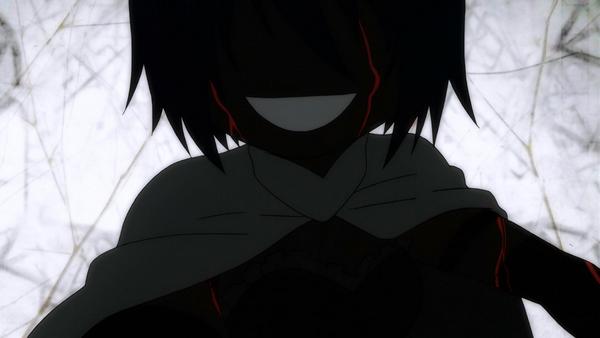 |
| © Magica Quartet / Aniplex |
Yandere and Yangire: Reviewing the Classic "Psycho" Archetypes
Yandere (ヤンデレ) and yangire (ヤンギレ) are archetypes referring to characters whose external cheerfulness, kindness, and innocence mask their internal mental instability. They appear normal on the outside, but are insane in the membrane. These characters often abandon their masks and succumb to madness as their stories progress. The prefix yan- in both terms is derived from the word yamu (病む) in reference to being in a state of mental illness. The suffix -dere in yandere comes from deredere (デレデレ), which has been appropriated in modern otaku culture as "being lovey dovey". The suffix -gire in yangire comes from kireru (切れる), "to snap suddenly and violently". The fundamental difference between the two archetypes is the source of their primary motivation. Yandere are driven to action by romantic attachment whereas yangire are driven by non-romantic motives such as caprice, jealousy, and irritation.
Gasai Yuno from Future Diary and Katsura Kotonoha from School Days are perhaps the most famous fictional yandere. Ryuuguu Rena from Higurashi no Naki Koro Ni and Tokisaki Kurumi from Date A Live are famous yangire, though Kurumi's obsession with Shidou qualifies her as a part-time yandere.
Menhera: An Operational Definition
Menhera (メンヘラ) is Internet slang derived from term menherā (メンヘラー), which itself is a derivation of "mental health-er", a nickname given to users of the 2channel mental health board (メンタルヘルス板). When it is used to refer to real human beings, menhera carries derogatory connotations. The English word closest in meaning to menhera is "psycho". Widespread adoption of the term has been impeded by its ambiguity and its negative connotations.
Looking at the term's origin, menhera ostensibly refers to people who exhibit symptoms of mental instability. The term has been used as a stereotypical label for users of the 2ch mental health board in reference to people who display insecure romantic attachments. In this context, menhera could refer to those with yandere tendencies. It has also been used in reference to people who commit insane and often violent acts while keeping an icy demeanour (a state of disinhibition). In this context, menhera refers to violent psychopaths and yangire. MyNavi published an article that listed Ryuuguu Rena, Gasai Yuno, Miki Sayaka, Amane Misa, and Senjougahara Hitagi as prime examples of menhera characters. The ambiguity of the term has led to its usage as an umbrella term that encompasses the better known yandere and yangire, but menhera has been overshadowed by yandere in practice.
In many contexts, menhera has become almost synonymous with yandere. It can be used as a derogatory label for people with personality disorders who validate their sense of self by seeking romantic affection from others. Menhera and yandere are primarily motivated by romantic love, both want senpai to notice them, but menhera are more likely to harm themselves whereas yandere might be more inclined to harm their rivals. For menhera, this romantic love is directed more toward the self than toward a significant other. However, some yandere exhibit self-destructive behaviour (including threats of murder-suicide), so the term yandere has essentially eclipsed menhera as a general label for someone with a personality disorder whose actions are motivated by distorted love.
To sum up the generalised differences between menhera, yandere, and yangire:
Menhera: "I'll kill myself/senpai if senpai doesn't notice me."
Yandere: "I'll kill anyone who gets between me and senpai."
Yangire: "I'll kill senpai if I feel like it."
Miki Sayaka: A Case Study
Warning: Puella Magi Madoka Magica spoilers ahead.
There is no such thing as a prototypical menhera, but the label could fit Miki Sayaka of Puella Magi Madoka Magica. Sayaka has major psychological and interpersonal issues, but she isn't usually considered a yandere (Hello, Homura!). She puts up a brave front to mask her inner insecurity. Sayaka's idealised view of romance and justice leads her down a path of crushed idealism, utter despair, and suicidal madness..
Upon forming a contract to become a magical girl, Sayaka presents herself as a selfless hero of love and justice. She strives to become a worthy successor to Mami, to become a hero who protects innocents from evil, and to win Kyousuke’s heart. Sayaka uses her one wish to cure Kyousuke’s ailment and insists on destroying familiars even though they don’t drop Grief Seeds. Her downfall begins when she learns that her wish came at the cost of becoming a lich bound to a soul gem. The revelation that she is no longer human warps Sayaka’s self image, but not her distorted ideals. She maintains a dichotomous view of morality (all-good vs. all-bad), rejecting Kyouko’s offering of a stolen apple along with Kyouko’s view that magical girls should fight for self-serving survival. Sayaka’s idealised romance begins to shatter when Hitomi announces that she will confess to Kyousuke. Sayaka later admits feeling a moment of regret for having previously saved Hitomi from a witch and realises that her “hero of justice” act has fallen apart. She convinces herself that she is unworthy of love and realises she cannot live up to expectations of an ideal hero. Even though she does not attempt to harm or kill her friend-turned-rival, Sayaka’s mental instability worsens in the absence of the mask that held her identity together. Her cognitive distortions become even more apparent when she switches off her sense of pain and goes berserk while attacking the witch Elsa Maria. She completely snaps after an encounter with a couple of male chauvinists on a train. Sayaka’s self-destructive spiral culminates not with death and rest, but with her transformation into the witch Oktavia von Seckendorff.
Sorry, Sayaka, your suffering doesn’t simply end when you stop cleansing your soul gem. You become a witch and then suffer some more (that is, until your universe gets rewritten by Madoka and then again by Homura).
Menhera (cont'd): Esoteric Overanalysis and Real World Comparisons
Nico Nico Pedia's page on menhera warns that the term is not recognised by medical professionals and could be used as a subjective label to describe (read: denigrate) people who have a different set of values from oneself or people who have a "unique" or "nonconformist" personality. It is prudent to remember that people should not automatically be viewed as patients/clients who require medical treatment simply because they have been assigned a label.
In the field of abnormal psychology, menhera is closely related to Axis II (Personality Disorders) of the DSM-IV-TR (Note: The DSM-5 has done away with the multi-axial system). Menhera exhibit symptoms that would suggest comorbidity for Cluster C (anxious/fearful) disorders such as dependent personality disorder and Cluster B (dramatic, emotional, or erratic) disorders such as borderline personality disorder, histrionic personality disorder, and narcissistic personality disorder. People diagnosed with personality disorders are often comorbid for other Axis II disorders (Tasman et al., 2008). Common characteristics exhibited by menhera include unstable interpersonal relationships, fear of abandonment, attention-seeking, issues with self identity, black-and-white thinking (also called splitting), lack of empathy, disinhibition, impulsive behaviour, and self-destructive behaviour. Someone labelled as being a menhera could meet the criteria for at least one of the personality disorders recognised by the DSM-IV-TR, DSM-5, or ICD-10, but diagnoses should only be performed by qualified medical professionals.
Developmental psychology and the science of interpersonal relationships can offer additional insights about menhera. The more narrow definition of menhera, characterised by the pursuit of romantic affection, shares characteristics exhibited by people with a preoccupied attachment style. Psychologists Kim Bartholomew and Leonard M. Horowitz presented a four-category model of adult attachment based on earlier work by pioneers in the development of attachment theory such as John Bowlby, Mary Ainsworth, Cindy Hazan, and Phillip Shaver. Under this model, people with preoccupied attachment styles harbour negative views of themselves, but positive views of valued others. They believe themselves to be unworthy or unlovable and construct their self-concept by seeking acceptance from others. In other words, they are “preoccupied” with their personal relationships (Bartholomew & Horowitz, 1991).
There is nothing close to an official set of criteria for identifying characters as being menhera. To reiterate, menhera is Internet slang and not scientific vocabulary. People and characters identified as such are not necessarily narcissists and do not necessarily have preoccupied attachment styles. It may be amusing to analyse fictional characters by diagnosing them with real (and very serious) psychological conditions, but is ultimately informed speculation at best. Despite social stigma against people with mental illnesses, the term yandere can be interpreted as a form of endearment depending on the speaker and the context whereas the term menhera almost always carries negative connotations. This peculiarity could be attributed to menhera‘s non-fictional origins and its status as a relatively unknown term. A quick scan of Pixiv submissions tagged as 「メンヘラ」 (Warning: possible NSFW user submissions) reveals only a handful of characters from recognisable series. In all likelihood, menhera will remain yandere‘s lesser known sibling, as it has not differentiated itself enough from yandere to warrant widespread adoption.
References
Bartholomew, K., Horowitz L.M., (1991). Attachment styles among young adults: a test of a four-category model. Journal of Personality and Social Psychology. 61(2):226-244. doi:10.1037/0022-3514.61.2.226
Tasman, A., Kay, J., Lieberman J.A., First, M.B., & Maj, M. (2008). Psychiatry, Third Edition. doi:10.1002/9780470515167
Addendum
The word menhera is also used in the context of art and fashion. Menhera-kei refers to a fashion style that incorporates medical themed makeup and accessories. The style typically features eyepatches, copious amounts of blush, and gratuitous use of the colours "baby blue" and "baby pink". Refer to your favourite search engine for more information on menhera in this context.
Addendum II
Niiyama Niko (Nico) of Kiznaiver is labelled in-universe as being fushigi menhera (不思議メンヘラ). Aniplex/Crunchyroll's official translation renders this as "Eccentric Headcase", where menhera = headcase.



















